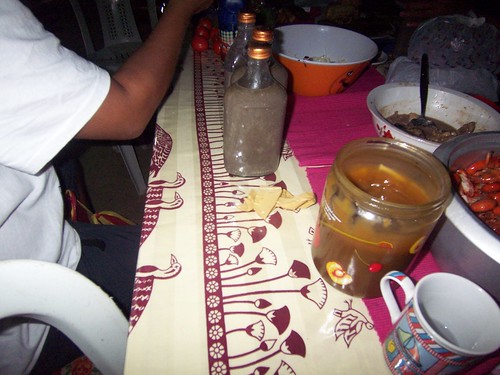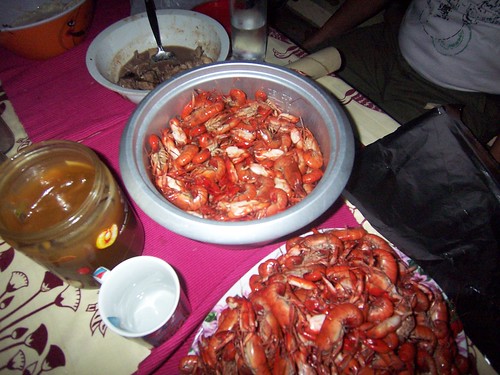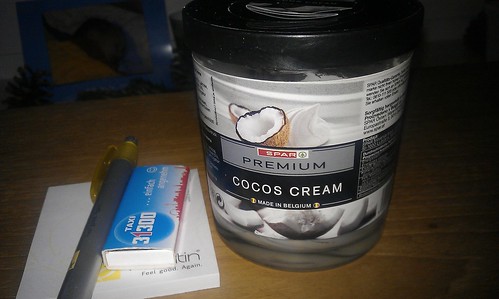English: Sweet Coconut / Deutsch: Süße Kokosnuss / Español: Coco Dulce / Português: Coco Doce / Français: Noix de Coco Sucrée / Italiano: Cocco Dolce /
Matamis na Bao also called Coconut Jam in English refers to a thick, sweet, syrupy stuff made from fresh coconut milk (Gata in Filipino) cooked with brown sugar or Panocha (Jaggery/Sangkaka) until it turns into spreadable consistency.
"Matamis Na Bao" which literally means sweetened (sweet is Matamis) coconut shell (Bao) is a traditional sweet spread, usually eaten at breakfast on toast/sandwich loaf (we call this kind of bread "sliced bread") or the Philippines very own bread called "Pandesal", freshly baked and hot from the oven is the best, or as spread for unsweetened crackers. It can also be used as dipping sauce for unsweetened rice delicacies called Suman.
Other varieties of this coconut jam are enjoyed throughout the Southeast Asian region, namely in Malaysia, Thailand and Singapore. In Malaysia, there is a very similar product called Kaya (a Nyonya Coconut and Egg Jam), the only differene is that they add egg to the recipe. It is used as a filling to make Kaya Bao (steamed buns filled with Kaya) or as a spread like the Matamis the Bao.
In my mother's home province, Marinduque , an island south of the Philippines, Matamis na Bao is called Kalamay-Hati and it is usually used as dipping sauce for the Suman.

The sugar used to make Matamis na Bao is basically molasses or raw sugar which is also called Panutsa, Panocha, Sangkaka, Pakaskas or Bao in Tagalog or Tagapulot (in Ilokano), much like the Indian jaggery.
Personal Note: I was also able to buy a bottle of sweetened Coconut jam so much like the Philippines "Matamis na Bao", in Vienna, Austria and in Germany, the only difference is the color. Here in Germany and Austria, it is colored white maybe because it is manufactured using white sugar plus the coconut milk. I can say, they almost taste the same, but my homesickness made me search for the distinct taste and smell our Philippines "Matamis na Bao".


Related Articles to the term 'Matamis na Bao' | |
| 'Buco / Buko' | ■■■■■■■■■ |
| Buco / Buko: Buco also spelled as Buko is a Filipino word that refers to a young coconut with soft, thin . . . Read More | |
| 'Kaya' | ■■■■■■■■■ |
| Kaya (Nyonya Coconut and Egg Jam) refers to a coconut jam from Malaysia which is made from coconut milk, . . . Read More | |
| 'Paldo' | ■■■■■■■■■ |
| Paldo is another Filipino name for Muscovado (sugar) or Panocha/ Panutsa/Panotsa which is one of the . . . Read More | |
| 'Halaya' | ■■■■■■■■■ |
| Halaya, in the food context, refers to a popular Filipino dessert known as Ube Halaya or Purple Yam Jam. . . . Read More | |
| 'Kamoteng Kahoy' | ■■■■■■■■ |
| Kamoteng Kahoy is a Filipino word for Cassava. It is also known as Yucca. In the Philippines, Kamoteng . . . Read More | |
| 'Puto' | ■■■■■■■■ |
| Puto is a filipino term for steamed rice cake. Puto is a traditional Filipino steamed rice cake that . . . Read More | |
| 'Sampalok' | ■■■■■■■ |
| Sampalok is a Filipino word for Tamarind. In the Philippines its pulp/fruit are eaten and used as a souring . . . Read More | |
| 'Xoi nuoc dua (with Recipe)' | ■■■■■■■ |
| Xoi nuoc dua (with Recipe) : Xoi nuoc dua is a Vietnamese dessert made of sweet rice with coconut. . . . . Read More | |
| 'Salak' | ■■■■■■■ |
| Salak (Salacca zalacca) one of popular Thai fruit described as pear-shaped, with dark brown scaly skin . . . Read More | |
| 'Puto Maya' | ■■■■■■■ |
| Puto Maya refers to a sweet snack from the Philippines which is made from boiled or steam glutinous or . . . Read More | |
